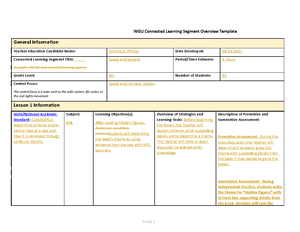- Information
- AI Chat
Was this document helpful?
Task 2 weather - passed
Course: Children's Literature (C269)
119 Documents
Students shared 119 documents in this course
University: Western Governors University
Was this document helpful?

WGU Connected Learning Segment Overview Template
General Information
Teacher Education Candidate Name: Melissa Catoe Date Developed: 11-27-20
Connected Learning Segment Title:
Descriptive title for your connected learning segment
Understanding the weather around
us and how to make predictions.
Period/Time Estimate: 7 hours
Grade Level: 4Number of Students: 20
Central Focus:
The central focus is a topic such as the solar system, life cycles, or
the civil rights movement.
Weather
Lesson 1 Information
State/National Academic
Standard:
Subject: Learning Objective(s):
(behavior, condition, criteria)
Overview of Strategies and
Learning Tasks:
Description of Formative and
Summative Assessment:
VA SOL 4.1 The student
will apply creative thinking
to art-making.
a) Apply imaginative
and expressive ideas.
b) Develop ideas
individually and
collaboratively.
.
Visual arts After reading the book “A Stroll
Through The Seasons” by Kay
Barnham, students will create
artwork of each season using
details from the book and their
imagination to achieve 4/5 on the
rubrics.
Lesson Resource:
The teacher will read “A Stroll
Through The Seasons” by Kay
Burnham.
Learning Task:
The teacher will ask open-ended
questions about their favorite
season and why.
The students will then discuss
among each other what happens
in each season as a group activity
Formative:
The teacher will walk around and
assess what they are discussing and
what ideas they are writing down on
their list. The teacher will give
prompts if needed to start
discussions.
Summative:
The teacher will use their four-
section artwork project to check for
creativity and imagination and score
PAGE 1
Students also viewed
Related documents
- Children's Lit Task 1 - Children’s literature task 1 passed
- Kyle childrens lit learning segment 6
- WGU Connected Learning Segment Template (2)
- Childrens lit lesson plan
- Childrens lit task 1 - Task 1 for Children's Literature Passed on the first attempt
- Task 1 - This is Task 1 for C 970. I passed without any revisions needed.







